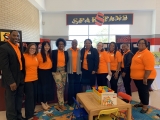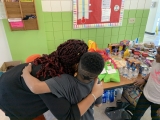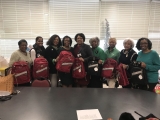-
Category 3
Selected in 2020
-
Grades: pre k - 5
School Setting: urban
Town Population: 278,993
Student Enrollment: 341
Student Demographics:
Black/African American: 41.7%
Teacher/Student Ratio: 1:22
White/Caucasian: 1.4%
Hispanic: 54%
Hawaiian/Pacific Islander: 0%
Asian: 0.6%
Native American: 0.3%
Other: 2%
% Reduced Lunch: 98.9%
% ELL Learners: 29.8%
Founded: 1911 -
PRINCIPAL:
Kimberly Ferrell -
CONTACT:
1500 Mathison Street
Durham, NC 27701
919-560-3908
kimberly_ferrell@dpsnc.net
Burton Magnet Elementary School
Durham, NC
Burton is a student focused school that has confidence in providing all students consistent access and equitable resources."


- Describe specific programs in place to ensure that families are involved in the success of your school and students.
- Families collaborate with school leaders, provide input, and participate in decision-making for school improvement. Burton’s Title I Parent Engagement Meeting, Family Engagement Team, and Family Academy provide opportunities for families to discuss data and strategies for improving student outcomes. We host community nights in McDougald Terrace Center (low-income housing community) to provide support and tutoring sessions to support student learning at home. The Burton Parent Teacher Organization (PTO) has helped to increase family engagement, implement programs, bridge partnerships with community organizations, and enhance fundraising efforts. The Parent Hispanic Advisory Council communicates with families to provide targeted support for our larger sub-groups. Community partnerships are established with various universities, businesses, and faith-based organizations. This includes relationships with The Links, Inc, Russell Memorial Church, and NC Central University.
- Describe the most successful activity your school has initiated to strengthen ties to your community.
- Burton received the Capturing Kids’ Hearts (CKH) National Showcase Schools award for three consecutive school years. CKH equips professionals in K-12 education to implement transformational processes focused on social-emotional wellbeing, relationship-driven culture, and student connectedness. Flip Flippen visited Burton in 2017 to celebrate how we transformed our campus into an emotionally safe and relationally connected place for students, staff, and parents to come alive with a love for learning. Districts around the state of NC visited our school to learn about the comprehensive and rigorous implementation of the CKH framework. Through this framework, Burton has increased attendance to 96%, exceeded academic achievement for 6 consecutive years, and decreased suspension rates to single digits. Capturing Kids Hearts allows Burton opportunities to increase community engagement through academic enrichment, social emotional support and resources and extra curricular activities.
- Describe your philosophy of school change or improvement.
- At Burton, we are committed to ensuring that the vision, mission, values, beliefs, and goals serve as a catalyst that drives our decisions and informs our culture. Our core belief is to hold everyone to high expectations. At Burton, we ensure that teachers are the leaders in their classroom and allow them the freedom to do their best work. Restructuring and redesigning the School Improvement Plan (SIP) to ensure we are increasing academic achievement, strengthening school, family, and community engagement and providing a safe and orderly environment that supports the whole child. Our School Improvement Planning process focuses on three strategic components for continuous improvement (Assessing, Creating, and Monitoring). At Burton we have aligned our School Improvement goals to the District’s Strategic Plan that provides us a blueprint to ensure improved academic outcomes for every student.
- What are your school’s top two goals for the next year?
-
Identifying and monitoring gaps in student learning and achievement, as well as assessing student progress frequently by using a variety of evaluation methods and making appropriate adjustments based on the needs of our students.
Continued use of Canvas as our school-wide learning management system so as to prepare students for a more seamless transition between synchronous and asynchronous learning. - What is the single most important factor in the success of your school that others could replicate?
-
Burton is a student focused school that has confidence in providing all students consistent access and equitable resources. Data and accountability drives instruction for students. Burton does not just use data, but we are immersed in it. The data we use is communicated frequently to help inform all decisions and initiatives. At Burton, we go past the collective use of data and make it personal for every child. We consistently build and implement personalized learning plans for students, based on the student’s need, strengths, and interests. We are intentional about providing students and families with wrap-around services that target the whole child. Despite Burton being 99% socio-economically disadvantaged, our students are 68% proficient on NC EOG assessments. Our model serves as an innovative framework for any school that desires to turn obstacles into opportunities by achieving grade level proficiency, exceeding growth, and sustaining a culture of high expectations.
- Describe the program or initiative that has had the greatest positive effect on student achievement, including closing achievement or opportunity gaps, if applicable.
- Our School Improvement Plan drives all school processes. Our indicators are focused on family engagement, academic achievement, social-emotional support, and personalizing student learning through the use of technology. At Burton teachers deliver robust, differentiated, culturally-responsive, and customized learning using evidence-based instructional practices to impact and sustain academic achievement for all students. High achievement will be sustained in the next two years by maintaining high expectations for all stakeholders. A Comprehensive Needs Assessment (CNA) will be conducted annually including a review of formative/summative data, NC Teacher Working Conditions data, NC Report Card data, EVAAS, teacher observation and student/family survey data to address the ongoing needs of the school for continuous improvement. Professional development for educators and family/community engagement opportunities will be planned and implemented based on the results of the CNA.
- Explain how ESEA federal funds are used to support your improvement efforts.
- Our ESEA funds will be allocated to support implementation of our Summer Bridge program. This program will be designed to bridge the academic gaps our students have experienced since schools mandatory shift to remote learning in March 2019 as a result of COVID-19. By providing our students and families with this Summer Bridge program, we aim to continue targeted instruction with our most vulnerable students.
- Identify the critical professional development activities you use to improve teaching and student learning.
- The implementation of evidence-based professional development revealed a correlation between our EVAAS growth data and academic achievement. Burton exceeded growth for 6 consecutive years. All subgroups exceeded growth, attributed to Differentiated Strategies for All Students with the EC District Team, Sheltered Instruction Observation Protocol (SIOP) Training, and MTSS Training. Teachers have received training in academic vocabulary using Isabel Beck’s “Bringing Words to Life”, literacy PD on Corrective Reading, The Friday Institute’s Teaching Foundational Reading Skills, Houghton Mifflin Harcourt’s Into Reading, resulting in a 15 point literacy gain. Burton’s PD plan supports social-emotional learning and behavior intervention. With PD on IB Primary Years Program, MTSS, Capturing Kids’ Hearts, and Positive Behavior Intervention Support (PBIS). The implementation of the PD attributed to reduced suspensions, increased attendance, low teacher turnover, and increased student achievement.
- Describe how data is used to improve student achievement and inform decision making.
-
We use multiple measures to inform our decision making process, and our teachers are engaged in analyzing demographic, perception, school process, and student academic data. These four measures provide a great opportunity to improve teaching and learning for every child at Burton. We use the Classroom-Focused Improvement Process (CFIP) model to examine subgroup data, consistently updated by teachers in PLCs. iReady is used as an universal screener to support our balanced literacy program.
Progress monitoring provides data points, which allows our teachers to differentiate instruction more effectively. Specialists and other instructional staff provide additional support to general education classrooms. Staff work with students on iReady, Lexia, Achieve 3000, Corrective Reading, and other curriculum activities. To strategically meet students' needs, we follow the Multi-Tiered System of Supports process. Baseline data, student self-assessment, and data notebooks track student progress. - Describe your school culture and explain changes you’ve taken to improve it.
- Creating a positive school culture for all has impacted the academic growth and achievement at Burton. Our culture is rooted in providing equitable educational opportunities for all students. We value the voices of all of our educational stakeholders, including teachers, parents, students, and community. We have enhanced the school culture for all members of the school community through the use of the Capturing Kids’ Hearts initiative in combination with Positive Behavior Intervention Support (PBIS). These programs have provided staff with strategies that impact the social-emotional learning of our students and families. We foster collaboration between the school leadership team and instructional leadership team, recognizing that teachers are experts in their field. Stakeholders are empowered to be active decision makers as an integral part of the school improvement process. These distributive leadership practices have enhanced the sense of efficacy and empowerment in the school.
Stats
-
Category 3
Selected in 2020
-
Grades: pre k - 5
School Setting: urban
Town Population: 278,993
Student Enrollment: 341
Student Demographics:
Black/African American: 41.7%
Teacher/Student Ratio: 1:22
White/Caucasian: 1.4%
Hispanic: 54%
Hawaiian/Pacific Islander: 0%
Asian: 0.6%
Native American: 0.3%
Other: 2%
% Reduced Lunch: 98.9%
% ELL Learners: 29.8%
Founded: 1911 -
PRINCIPAL:
Kimberly Ferrell -
CONTACT:
1500 Mathison Street
Durham, NC 27701
919-560-3908
kimberly_ferrell@dpsnc.net










